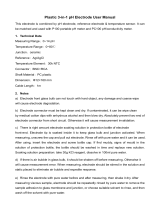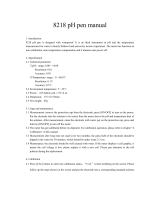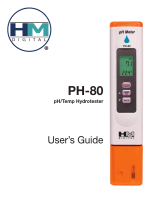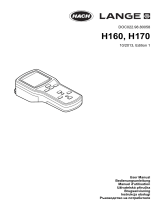
EC600 V2.0 4/10
9
pH Measurement, Calibration, and Electrode Considerations
• Error messages ERR-1: Electrode zero potential error and ERR-2: Electrode slope
error; For either error, check the following:
1. Air bubbles in the electrode bulb. Shake rigorously to remove air bubbles
2. Accuracy of the pH buffers used in calibration. Replace buffers if necessary
3. Set meter to its factory default state in Parameter P7 (previous section of manual)
• Calibration intervals depend on the sample, the electrode performance, and the
required accuracy. For high accuracy measurements (≤ ±0.02pH), the meter should be
calibrated immediately before taking a measurement. For general accuracy (≥±0.1pH),
the meter can be calibrated and used for approximately one week before the next
calibration.
• The meter must be recalibrated in the following situations:
1. New probe, or probe that is unused for a long period of time
2. After measuring acids (pH<2) or alkaline solutions (pH>12)
3. After measuring a solution that contains fluoride or a concentrated organic solution
4. If the solution’s temperature differs widely from the calibration solution temperature
• The soaking solution contained in the supplied protective bottle is used to maintain
activation in the glass bulb and junction. Loosen the capsule, remove the electrode and
rinse in distilled water before taking a measurement. Insert the electrode and tighten
the capsule after measurements to prevent the solution from leaking. If the soak
solution is turbid or moldy, replace the solution.
• To prepare a soak solution: Use 25g pure KCL dissolved with purified water and diluted
to 100mL. The electrode should not be soaked in a purified water protein solution or an
acid fluoride solution for long periods of time. In addition, do not soak the electrode in
organic silicon lipids.
• For calibration accuracy, the pH of the standard buffer solution must be reliable. The
buffer solution should be refreshed often, especially after heavy use.
• For best accuracy, always keep the meter clean and dry, especially the meter’s
electrode and electrode jack. Clean with medical cotton and alcohol if necessary.
• The sensitive glass bulb at the front of the combination electrode should not come in
contact with hard surfaces. Scratches or cracks on the electrode will cause inaccurate
readings. Before and after each measurement, the electrode should be washed with
distilled water and air dried. Do not clean the glass bulb with a tissue for it will affect the
stability of the electrode potential and increase the response time. The electrode
should be thoroughly cleaned if a sample sticks to the electrode. Use a solvent if the
solution does not appear clean after washing.
• Electrodes that have been used over a long period of time, used in a strong solution
that has damaged the sensitive bulb, or used with a substance resulting in a jam at the
junction will be become passivated; the sensitivity will decrease, its response will slow,
and the readings will be inaccurate. Replace the electrode as soon as possible in these
cases.
• For abnormal readings, try calibrating again; if the problem persists replace the
Electrode. The user can also try resetting the meter to factory default conditions per
Parameter P7 (detailed in an earlier section). Electrode life can be shortened by heavy
use, extreme conditions, and improper maintenance.
www.burntec.comwww.burntec.com





















